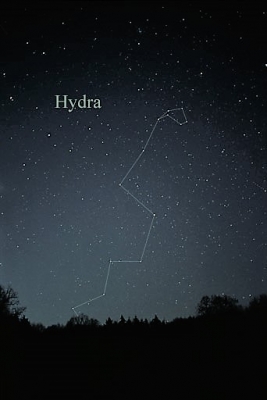WHICH IS THE LARGEST CONSTELLATION?

Hydra is the largest of the 88 modern constellations, measuring 1303 square degrees, and also the longest at over 100 degrees. Its southern end borders Libra and Centaurus and its northern end borders Cancer. It was included among the 48 constellations listed by the 2nd century astronomer Ptolemy. Commonly represented as a water snake, it straddles the celestial equator.
Despite its size, Hydra contains only one moderately bright star, Alphard, designated Alpha Hydrae. It is an orange giant of magnitude 2.0, 177 light-years from Earth. Its traditional name means "the solitary one". Beta Hydrae is a blue-white star of magnitude 4.3, 365 light-years from Earth. Gamma Hydrae is a yellow giant of magnitude 3.0, 132 light-years from Earth.
Hydra has one bright binary star, Epsilon Hydrae, which is difficult to split in amateur telescopes; it has a period of 1000 years and is 135 light-years from Earth. The primary is a yellow star of magnitude 3.4 and the secondary is a blue star of magnitude 6.7. However, there are several dimmer double stars and binary stars in Hydra. 27 Hydrae is a triple star with two components visible in binoculars and three visible in small amateur telescopes. The primary is a white star of magnitude 4.8, 244 light-years from Earth. The secondary, a binary star, appears in binoculars at magnitude 7.0 but is composed of a magnitude 7 and a magnitude 11 star; it is 202 light-years from Earth. 54 Hydrae is a binary star 99 light-years from Earth, easily divisible in small amateur telescopes. The primary is a yellow star of magnitude 5.3 and the secondary is a purple star of magnitude 7.4. N Hydrae (N Hya) is a pair of stars of magnitudes 5.8 and 5.9. Struve 1270 (?1270) consists of a pair of stars, magnitudes 6.4 and 7.4.
The other main named star in Hydra is Sigma Hydrae (? Hydrae), which also has the name of Minchir, from the Arabic for snake's nose. At magnitude 4.54, it is rather dim. The head of the snake corresponds to the ?shlesh? Nakshatra, the lunar zodiacal constellation in Indian astronomy. The name of Nakshatra (Ashlesha) became the proper name of Epsilon Hydrae since 1 June 2018 by IAU.
Hydra is also home to several variable stars. R Hydrae is a Mira variable star 2000 light-years from Earth; it is one of the brightest Mira variables at its maximum of magnitude 3.5. It has a minimum magnitude of 10 and a period of 390 days. V Hydrae is an unusually vivid red variable star 20,000 light-years from Earth. It varies in magnitude from a minimum of 9.0 to a maximum of 6.6. Along with its notable color, V Hydrae is also home to at least two exoplanets. U Hydrae is a semi-regular variable star with a deep red color, 528 light-years from Earth. It has a minimum magnitude of 6.6 and a maximum magnitude of 4.2; its period is 115 days.
Hydra includes GJ 357, an M-type main sequence star located only 31 light-years from the Solar System. This star has three confirmed exoplanets in its orbit, one of which, GJ 357 d, is considered to be a "Super-Earth" within the circumstellar habitable zone.
Credit : Wikipedia
Picture Credit : Google
Comments
No comments